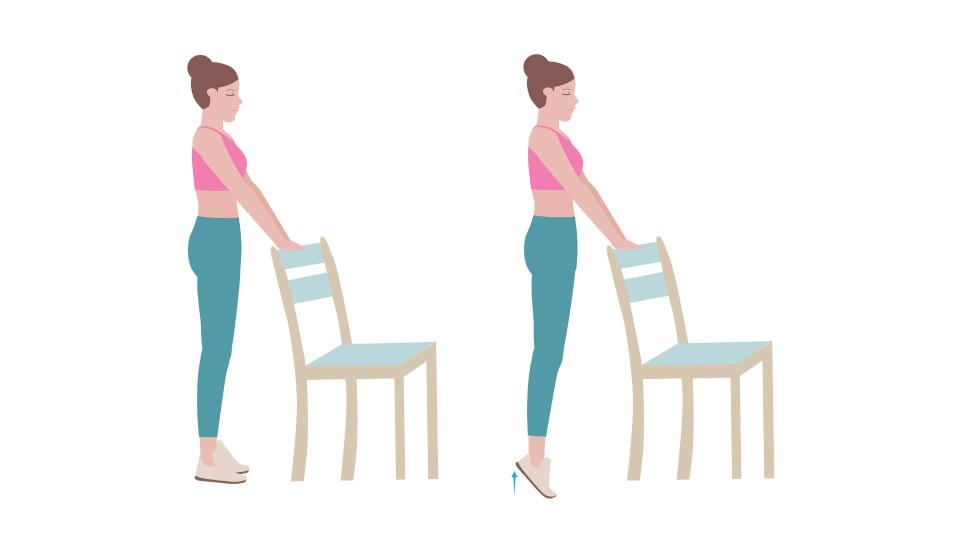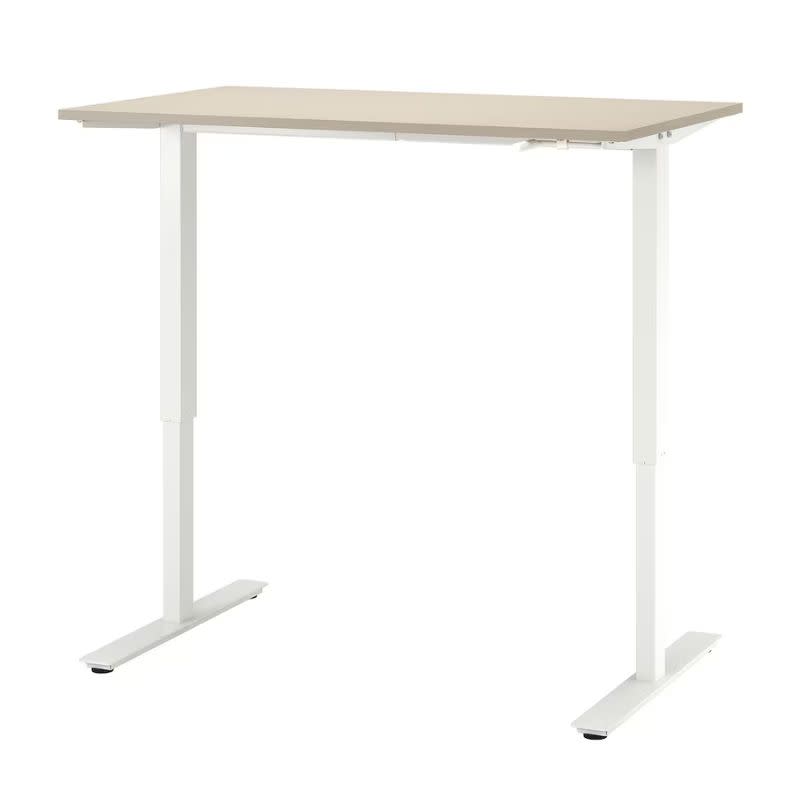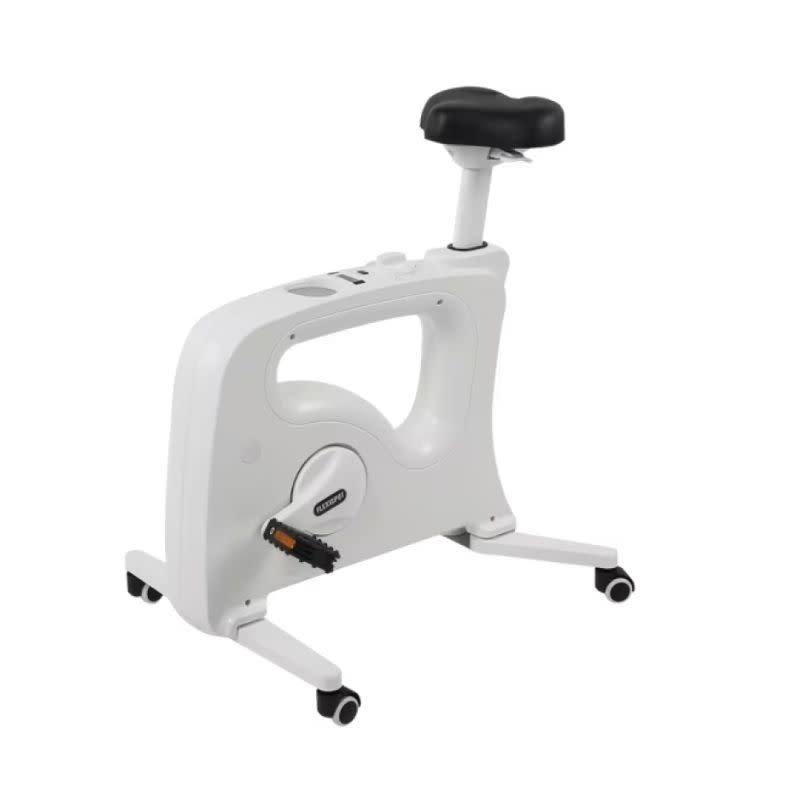5 easy desk exercises to loosen up your muscles, build strength and boost concentration

We all know that sitting down for too many hours too often isn't ideal for our physical and mental health - and that's where desk exercises can come in.
Spending hours behind a desk is sometimes unavoidable, even with all the best intentions. Long days at work or doing admin can leave you feeling the need to stretch out.
As a form of exercise snacking, desk exercises are simple movements designed to loosen up the joints, stretch the muscles, and help you refocus your concentration. Similarly to a chair workout, all you need is your desk, a chair, and a few minutes throughout the day.
Desk exercises
1. Squats

Squats are one of the best strength training exercises for beginners at home. They work to strengthen the leg muscles, boost core strength, maintain balance, and can be adapted to work with your current fitness level.
How to do a desk squat, according to personal trainer and women's fitness specialist Sarah Campus:
Stand in front of a chair with your feet shoulder-width apart.
Put your arms across your chest with your hands touching your shoulders or hold them out in front of you.
Push your hips backwards, bend your knees and lower yourself slowly down onto your chair.
Once you can do 12 of these chair squats, you might want to make them harder by adding a set of the best resistance bands or dumbbells. Adding resistance will make the squat harder, raising your heart rate and body temperature, so choose your weight wisely if you've got a busy day.
2. Calf raises

The two calf muscles provide 80% of the force needed to push your legs forward when your foot hits the ground, per Stanford University research. Yet, unless you're walking uphill or at speed, going up and down stairs, or doing cycling as a workout at least once a week, you're unlikely to be engaging these muscles specifically all that much.
Yet, they are one of the most important muscles in the body for supporting the legs.
How to do calf raises at your desk:
Using the top of the desk or the back of a stable chair for support, stand hip-width apart and slowly lift your heels off the floor.
Balance on your toes for three to four seconds while engaging the calf muscle, then slowly lower back onto your whole foot.
Do 12-15 reps of this exercise.
Top tip: Be sure to stretch out before doing this exercise. Suddenly using it without warming up can lead to discomfort and even injury.
3. Split squats

Challenge your mind and body with split squats, using your desk for support, suggests Campus, who is also the founder of LDN Mums Fitness. This is a single-leg exercise that can help to improve your balance and coordination and boost leg strength.
If needed, place one hand on the desk for balance support as you lower yourself into the split squat. It's also best to use a stable chair for this exercise, rather than one that spins or has wheels.
How to do a split squat at your desk:
Stand in front of a chair or step roughly two feet away, with your feet should be hip-width apart, Campus says.
Lift your right leg and put it on the chair behind you, using the desk for balance if you need to.
You can either place the top of your foot on the chair, so your ankle joint is on the edge of the chair or flex your ankle and balance on the ball of your foot.
Make sure your feet are still roughly hip-distance apart, with your hips facing forward
Engage your core and bend your left knee, as you would in a lunge.
Pause at the bottom, then drive back up to your starting position.
Make sure you perform the same number of repetitions on each side to keep things even - aim for five on each side to begin with, three times throughout the day.
"The hardest part of the split squat is getting your legs into the right position," says Campus. You'll know you're in the right position when the knee of your back leg sits just behind your hips.
"Remember, you’re working the front leg - your back leg is just offering some stability in this exercise," she adds.
4. Abdominal flexes

Abdominal flexes are just a fancy name for tightening and relaxing the muscles around the belly. It's a "simple exercise that can help you strengthen your core while standing behind a desk," says Rowan Clift, a certified personal trainer and specialist at AI-based fitness and lifestyle coaching app Freeletics, one of the best workout apps. Much like pelvic floor yoga exercises to train your pelvic floor from a seated position, you can do this one sitting down.
How to flex your abdominal muscles at your desk:
Standing behind your chair hip-width apart or sitting behind the desk, flex your abdominal muscles.
To do this, start with a deep inhale that fills up your belly.
Imagine using your abdominal muscles to pull your belly button up and inward, without breathing in.
Under your touch, it should feel like your abdominal muscles have hardened.
Try doing this 10 times, three times throughout the day.
5. Press ups

Press-ups are an excellent movement and one of the best desk exercises. They use several muscles, ticking multiple boxes at once so you don't have to do many desk exercises to loosen up your upper body and maintain strength in this area. It's also one of the best core exercises to do at home.
For this exercise, however, you must have a sturdy set-up - for example, a desk that sits against a wall, rather than one that can move when pushed. Equally, you may prefer to move your desk chair against a wall.
How to do a desk press-up, according to PT Campus:
Stand in front of a sturdy chair and place your hands on the edge of the seat.
Step back into a plank position keeping your shoulders directly above your wrists.
Bend your elbows, lower your entire body down as far as you can and press back up.
Are desk workouts effective?
Yes, whether you do very little exercise or regularly hit the recommended 150 minutes a week, adding in some desk exercises can make a world of difference to your wellbeing.
"Sitting for prolonged periods can slow down metabolism, which affects our body’s ability to regulate blood sugar levels and blood pressure and metabolise fat," says Clift. If you're looking to lose weight healthily - especially if your focus is weight loss in menopause - then this is important. Boosting the metabolism means you will burn more calories at rest as you sit behind the desk, contributing positively to a calorie deficit.
"Being inactive or sitting in one place for too long can also increase the chances of lower back pain and neck spasms. This could significantly affect your posture and normal spine curvature. The normal discs in your spine over time can become compressed due to poor posture and your hip flexors can shorten and tighten, causing further strain on your lower back," he notes.
What about a standing desk?
If you sit behind a desk for more hours than not throughout the day, it may be worth considering getting a standing desk, a walking pad, or a seated bike to being inactive and sitting down for too long, too often.
"Introducing a standing desk, standing at your current desk or work surface, or introducing a workout can be very beneficial," says Clift. "Standing at your desk rather than sitting for long periods during a working day can offer a myriad of health benefits, including a lowered risk of obesity, lower blood sugar levels, a decreased risk of heart disease, reduced back pain, improved energy levels, and boosted productivity levels."

IKEA TROTTEN Desk
Using a simple crank handle, this desk from IKEA allows you to move from sitting at 70cm to standing at 120cm. Fully adjustable and with four colourways to choose from, there will be a Trotten option to suit your space.

Huzevay Under Desk Treadmill
If you want to move more throughout the day, why not consider an under-desk walking pad? With the cosy cardio trend still going strong, these machines can help you get your steps behind your (standing) desk.

FlexiSpot Cycle Desk Bike V9 Pro
Stay seated while staying moving? Best of both worlds. The FlexiSpot Cycle Desk Bike V9 Pro is a desk-bike hybrid and a chance to reap the benefits of indoor cycling, with a fully adjustable bike system and desk so you can work independently. The desk is also removable, should you prefer your own standing desk set-up.


